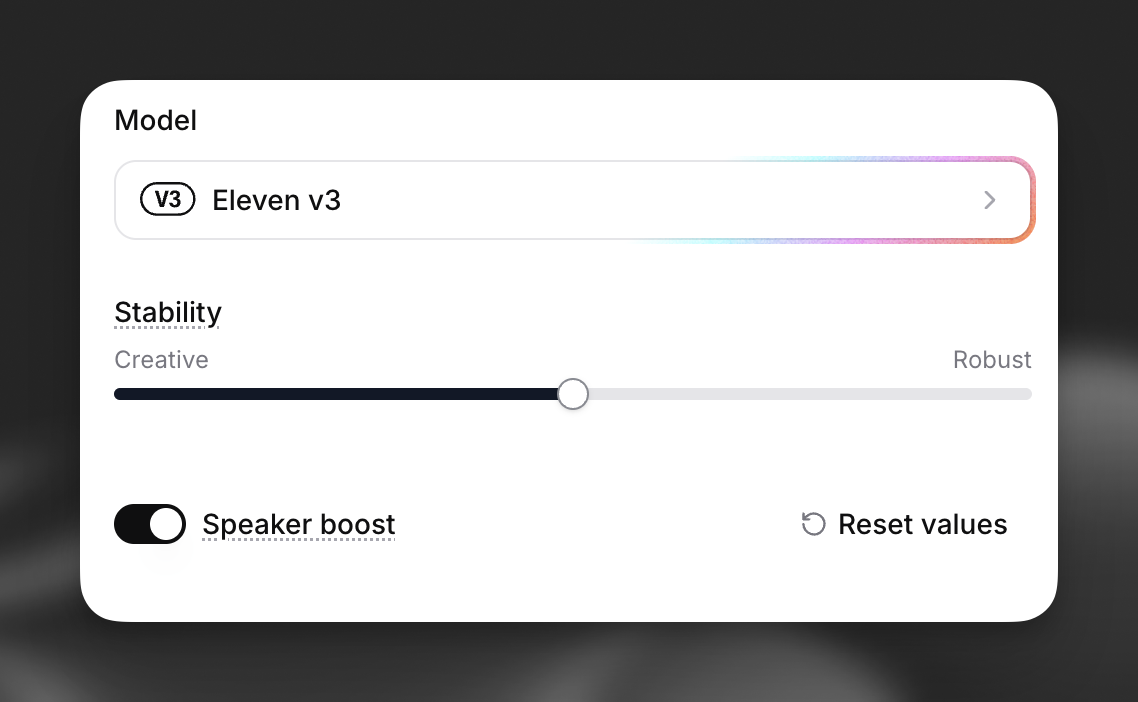Prompting Eleven v3 (alpha)
This guide provides the most effective tags and techniques for prompting Eleven v3, including voice selection, changes in capitalization, punctuation, audio tags and multi-speaker dialogue. Experiment with these methods to discover what works best for your specific voice and use case.
Eleven v3 is in alpha. Very short prompts are more likely to cause inconsistent outputs. We encourage you to experiment with prompts greater than 250 characters.
Voice selection
The most important parameter for Eleven v3 is the voice you choose. It needs to be similar enough to the desired delivery. For example, if the voice is shouting and you use the audio tag [whispering], it likely won’t work well.
When creating IVCs, you should include a broader emotional range than before. As a result, voices in the voice library may produce more variable results compared to the v2 and v2.5 models. We’ve compiled over 22 excellent voices for V3 here.
Choose voices strategically based on your intended use:
Emotionally diverse
For expressive IVC voices, vary emotional tones across the recording—include both neutral and dynamic samples.
Targeted niche
For specific use cases like sports commentary, maintain consistent emotion throughout the dataset.
Neutral
Neutral voices tend to be more stable across languages and styles, providing reliable baseline performance.
Professional Voice Clones (PVCs) are currently not fully optimized for Eleven v3, resulting in potentially lower clone quality compared to earlier models. During this research preview stage it would be best to find an Instant Voice Clone (IVC) or designed voice for your project if you need to use v3 features.
Settings
Stability
The stability slider is the most important setting in v3, controlling how closely the generated voice adheres to the original reference audio.

- Creative: More emotional and expressive, but prone to hallucinations.
- Natural: Closest to the original voice recording—balanced and neutral.
- Robust: Highly stable, but less responsive to directional prompts but consistent, similar to v2.
For maximum expressiveness with audio tags, use Creative or Natural settings. Robust reduces responsiveness to directional prompts.
Audio tags
Eleven v3 introduces emotional control through audio tags. You can direct voices to laugh, whisper, act sarcastic, or express curiosity among many other styles. Speed is also controlled through audio tags.
The voice you choose and its training samples will affect tag effectiveness. Some tags work well
with certain voices while others may not. Don’t expect a whispering voice to suddenly shout with a
[shout] tag.
Voice-related
These tags control vocal delivery and emotional expression:
[laughs],[laughs harder],[starts laughing],[wheezing][whispers][sighs],[exhales][sarcastic],[curious],[excited],[crying],[snorts],[mischievously]
Sound effects
Add environmental sounds and effects:
[gunshot],[applause],[clapping],[explosion][swallows],[gulps]
Unique and special
Experimental tags for creative applications:
[strong X accent](replace X with desired accent)[sings],[woo],[fart]
Some experimental tags may be less consistent across different voices. Test thoroughly before production use.
Punctuation
Punctuation significantly affects delivery in v3:
- Ellipses (…) add pauses and weight
- Capitalization increases emphasis
- Standard punctuation provides natural speech rhythm
Single speaker examples
Use tags intentionally and match them to the voice’s character. A meditative voice shouldn’t shout; a hyped voice won’t whisper convincingly.
Expressive monologue
Dynamic and humorous
Customer service simulation
Multi-speaker dialogue
v3 can handle multi-voice prompts effectively. Assign distinct voices from your Voice Library for each speaker to create realistic conversations.
Dialogue showcase
Glitch comedy
Overlapping timing
Enhancing input
In the ElevenLabs UI, you can automatically generate relevant audio tags for your input text by clicking the “Enhance” button. Behind the scenes this uses an LLM to enhance your input text with the following prompt:
Tips
Tag combinations
You can combine multiple audio tags for complex emotional delivery. Experiment with different combinations to find what works best for your voice.
Voice matching
Match tags to your voice’s character and training data. A serious, professional voice may not
respond well to playful tags like [giggles] or [mischievously].
Text structure
Text structure strongly influences output with v3. Use natural speech patterns, proper punctuation, and clear emotional context for best results.
Experimentation
There are likely many more effective tags beyond this list. Experiment with descriptive emotional states and actions to discover what works for your specific use case.